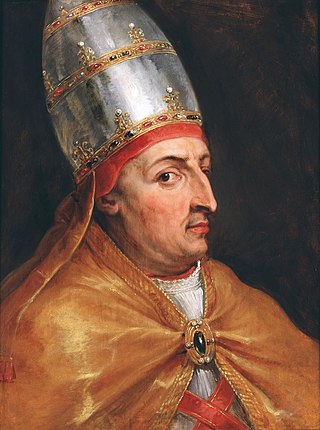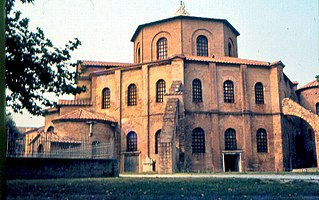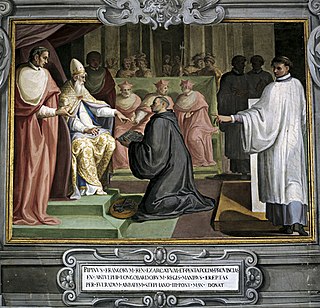
Charlemagne or Charles the Great, a member of the Carolingian dynasty, was King of the Franks from 768, King of the Lombards from 774, and was crowned as the Emperor of the Romans by Pope Leo III in 800. Charlemagne succeeded in uniting the majority of western and central Europe and was the first recognized emperor to rule from western Europe after the fall of the Western Roman Empire approximately three centuries earlier. The expanded Frankish state that Charlemagne founded was the Carolingian Empire, which is considered the first phase in the history of the Holy Roman Empire. He was canonized by Antipope Paschal III—an act later treated as invalid—and he is now regarded by some as beatified in the Catholic Church.

Pope Leo III was bishop of Rome and ruler of the Papal States from 26 December 795 to his death. Protected by Charlemagne from the supporters of his predecessor, Adrian I, Leo subsequently strengthened Charlemagne's position by crowning him emperor. The coronation was not approved by most people in Constantinople, although the Byzantines, occupied with their own defenses, were in no position to offer much opposition to it.

Pope Gregory IV was the bishop of Rome and ruler of the Papal States from October 827 to his death. His pontificate was notable for the papacy’s attempts to intervene in the quarrels between Emperor Louis the Pious and his sons. It also saw the breakup of the Carolingian Empire in 843.
Pope Stephen IX was the head of the Catholic Church and ruler of the Papal States from 3 August 1057 to his death in 29 March 1058. He was a member of the Ardenne-Verdun family, who ruled the Duchy of Lorraine, and started his ecclesiastical career as a canon in Liège. He was invited to Rome by Pope Leo IX, who made him chancellor in 1051 and one of three legates to Constantinople in 1054. The failure of their negotiations with Patriarch Michael I Cerularius of Constantinople and Archbishop Leo of Ohrid led to the permanent East–West Schism. He continued as chancellor to the next pope, Victor II, and was elected abbot of the Benedictine monastery of Montecassino.

Pope Sergius I was the bishop of Rome from 15 December 687 to his death, and is revered as a saint by the Roman Catholic Church. He was elected at a time when two rivals, Paschal and Theodore, were locked in a dispute about which of them should become pope. His papacy was dominated by his response to the Quinisext Council, the canons of which he steadfastly refused to accept. Thereupon Emperor Justinian II ordered Sergius' arrest, but the Roman people and the Italian militia of the exarch of Ravenna refused to allow the exarch to bring Sergius to Constantinople.

Pope Nicholas V, born Tommaso Parentucelli, was head of the Catholic Church and ruler of the Papal States from 6 March 1447 until his death, in March 1455. Pope Eugene IV made him a cardinal in 1446 after successful trips to Italy and Germany, and when Eugene died the next year, Parentucelli was elected in his place. He took his name Nicholas in memory of his obligations to Niccolò Albergati.

The Papal States, officially the State of the Church, were a series of territories in the Italian Peninsula under the direct sovereign rule of the pope from 756 until 1870. They were among the major states of Italy from the 8th century until the unification of Italy, between 1859 and 1870.
Pope Nicholas I, called Nicholas the Great, was the bishop of Rome and ruler of the Papal States from 24 April 858 until his death. He is remembered as a consolidator of papal authority, exerting decisive influence on the historical development of the papacy and its position among the Christian nations of Western Europe. Nicholas I asserted that the pope should have suzerainty over all Christians, even royalty, in matters of faith and morals.
Pope John XIII was the bishop of Rome and ruler of the Papal States from 1 October 965 to his death. His pontificate was caught up in the continuing conflict between the Holy Roman emperor, Otto I, and the Roman nobility. After long and arduous negotiations, he succeeded in arranging a Byzantine marriage for Otto II, in an effort to legitimize the Ottonian claim to imperial dignity. He also established church hierarchy in Poland and Bohemia.

Pepin the Short, was King of the Franks from 751 until his death in 768. He was the first Carolingian to become king.

An antiphonary or antiphonal is one of the liturgical books intended for use in choro, and originally characterized, as its name implies, by the assignment to it principally of the antiphons used in various parts of the Latin liturgical rites.
Timeline for Music of Italy
The Patrimony of Saint Peter originally designated the landed possessions and revenues of various kinds that belonged to the apostolic Holy See i.e. the "Church of Saint Peter" in Rome, by virtue of the apostolic see status as founded by Saint Peter, according to Catholic tradition. Until the middle of the 8th century this consisted wholly of private property, later, its meaning corresponded to the territories under Papal sovereignty, more particularly to the Duchy of Rome, but from the early 13th century the term was applied to one of the four provinces of the States of the Church.
Gallican chant refers to the liturgical plainchant repertory of the Gallican rite of the Roman Catholic Church in Gaul, prior to the introduction and development of elements of the Roman rite from which Gregorian chant evolved. Although the music was largely lost, traces are believed to remain in the Gregorian corpus.
Cuno of Praeneste was a German Cardinal and papal legate, an influential diplomatic figure of the early 12th century, active in France and Germany. He held numerous synods throughout Europe, and excommunicated the Emperor Henry V numerous times, in the struggle over the issue of lay investiture of ecclesiastical offices. He spent six years promoting the acceptance of Thurstan of York as archbishop by King Henry I of England, without making York subject to Canterbury. He was seriously considered for election to the papacy in 1119, which he refused.
The Cappella Giulia, officially the Reverend Musical Chapel Julia of the Sacrosanct Papal Basilica of Saint Peter in the Vatican, is the choir of St. Peter's Basilica that sings for all solemn functions of the Vatican Chapter, such as Holy Mass, Lauds, and Vespers, when these are not celebrated by the Pope. The choir has played an important role as an interpreter and a proponent of Gregorian chant and sacred polyphony.

The Byzantine Papacy was a period of Byzantine domination of the Roman papacy from 537 to 752, when popes required the approval of the Byzantine Emperor for episcopal consecration, and many popes were chosen from the apocrisiarii or the inhabitants of Byzantine-ruled Greece, Syria, or Sicily. Justinian I reconquered the Italian peninsula in the Gothic War (535–554) and appointed the next three popes, a practice that would be continued by his successors and later be delegated to the Exarchate of Ravenna.

The Holy Roman Emperor received the imperial regalia from the hands of the Pope, symbolizing both the pope's right to crown Christian sovereigns and also the emperor's role as protector of the Roman Catholic Church. The Holy Roman empresses were crowned as well.

From 756 to 857, the papacy shifted from the influence of the Byzantine Empire to that of the kings of the Franks. Pepin the Short, Charlemagne, and Louis the Pious had considerable influence in the selection and administration of popes. The "Donation of Pepin" (756) ratified a new period of papal rule in central Italy, which became known as the Papal States.
The Schola Cantorum was the trained papal choir during the Middle Ages, specializing in the performance of plainchant for the purpose of rendering the music in church. In the fourth century, Pope Sylvester I was said to have inaugurated the first Schola Cantorum, but it was Pope Gregory I who established the school on a firm basis and endowed it. The choir ranged anywhere from twenty to thirty boys or men. Only the most skilled in singing were selected to participate in the Schola Cantorum.










